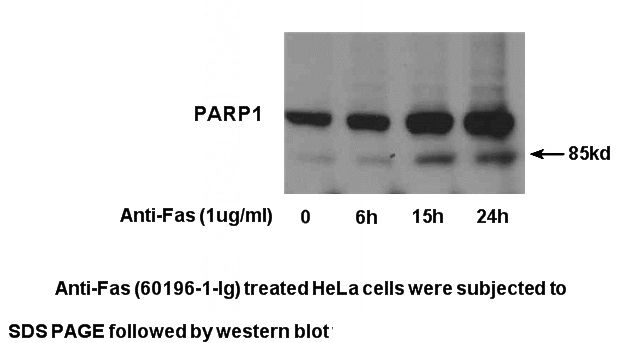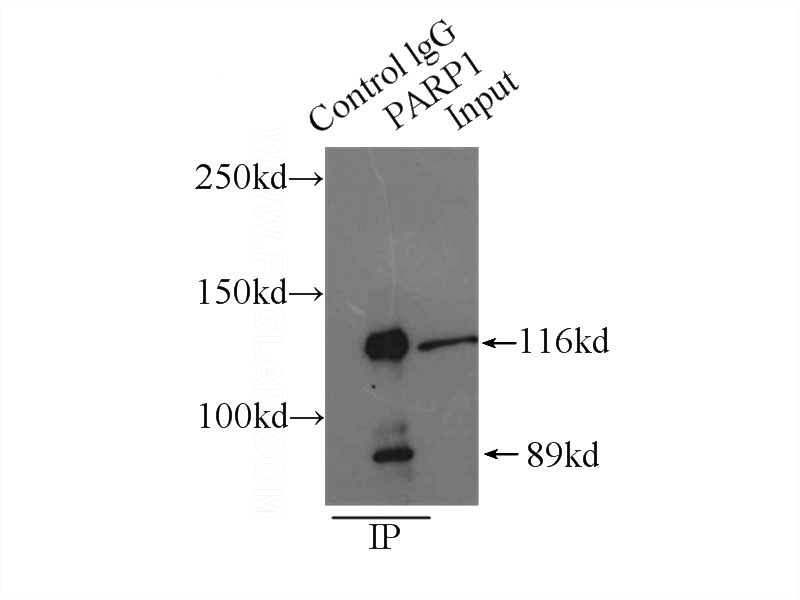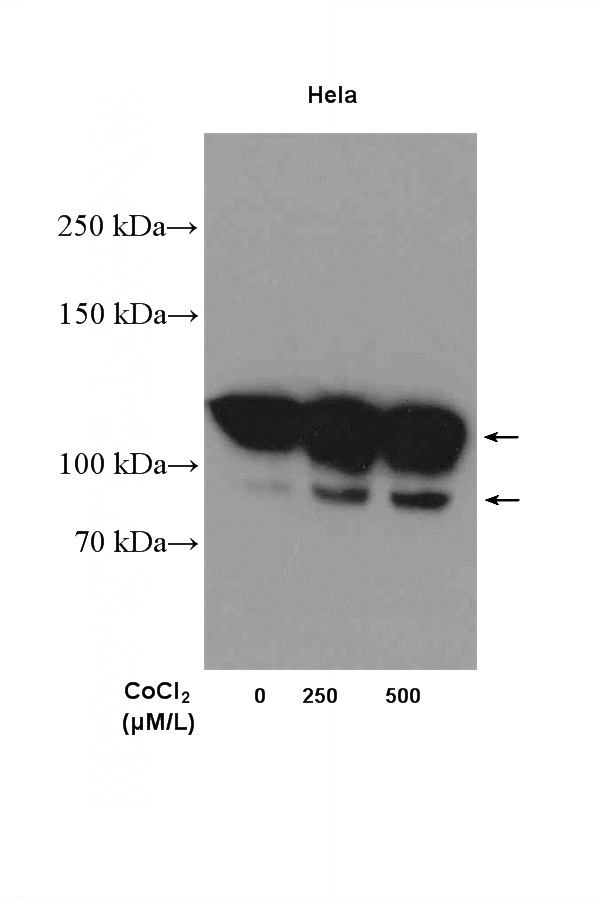-
Product Name
PARP1 antibody
- Documents
-
Description
PARP1 Rabbit Polyclonal antibody. Positive IP detected in K-562 cells. Positive WB detected in Fas antibody treated HeLa cells, A549 cells, Cobalt Chloride treated HeLa cells, HeLa cells, Jurkat cells, K-562 cells, Raji cells, Staurosporine treat Jurkat cells, Y79 cells. Observed molecular weight by Western-blot: 113-116 kDa
-
Tested applications
ELISA, IP, WB
-
Species reactivity
Human,Mouse,Rat; other species not tested.
-
Alternative names
ADPRT antibody; ADPRT 1 antibody; ADPRT1 antibody; pADPRT 1 antibody; PARP antibody; PARP 1 antibody; PARP1 antibody; poly (ADP ribose) polymerase 1 antibody; Poly [ADP ribose] polymerase 1 antibody; Poly[ADP ribose] synthase 1 antibody; PPOL antibody
-
Isotype
Rabbit IgG
-
Preparation
This antibody was obtained by immunization of PARP1 recombinant protein (Accession Number: NM_001618). Purification method: Antigen affinity purified.
-
Clonality
Polyclonal
-
Formulation
PBS with 0.02% sodium azide and 50% glycerol pH 7.3.
-
Storage instructions
Store at -20℃. DO NOT ALIQUOT
-
Applications
Recommended Dilution:
WB: 1:500-1:5000
IP: 1:200-1:2000
-
Validations

Anti-Fas treated HeLa cells were subjected to SDS PAGE followed by western blot with Catalog No:113588 (PARP1 Antibody) at dilution of 1:1000.

IP Result of anti-PARP1 (IP:Catalog No:113588, 4ug; Detection:Catalog No:113588 1:600) with K-562 cells lysate 5000ug.

Cobalt Chloride treated HeLa cells were subjected to SDS PAGE followed by western blot with Catalog No:113588(PARP1 Antibody) at dilution of 1:1000
-
Background
PARP1 (poly(ADP-ribose) polymerase 1) is a nuclear enzyme catalyzing the poly(ADP-ribosyl)ation of many key proteins in vivo. The normal function of PARP1 is the routine repair of DNA damage. Activated by DNA strand breaks, the PARP1 is cleaved into an 85 to 89-kDa COOH-terminal fragment and a 24-kDa NH2-terminal peptide by caspases during the apoptotic process. The appearance of PARP fragments is commonly considered as an important biomarker of apoptosis. In addition to caspases, other proteases like calpains, cathepsins, granzymes and matrix metalloproteinases (MMPs) have also been reported to cleave PARP1 and gave rise to fragments ranging from 42-89-kD. This antibody was generated against the C-terminal region of human PARP1 and it recognizes the full-length as well as the cleavage of the PARP1.
-
References
- Chen W, Hou J, Yin Y. alpha-Bisabolol induces dose- and time-dependent apoptosis in HepG2 cells via a Fas- and mitochondrial-related pathway, involves p53 and NFkappaB. Biochemical pharmacology. 80(2):247-54. 2010.
- Lei JC, Yu JQ, Yin Y, Liu YW, Zou GL. Alantolactone induces activation of apoptosis in human hepatoma cells. Food and chemical toxicology : an international journal published for the British Industrial Biological Research Association. 50(9):3313-9. 2012.
- Tu JB, Ma RZ, Dong Q. Induction of apoptosis in infantile hemangioma endothelial cells by propranolol. Experimental and therapeutic medicine. 6(2):574-578. 2013.
- Xu T, Zheng L, Xu L. Protective effects of dioscin against alcohol-induced liver injury. Archives of toxicology. 88(3):739-53. 2014.
- Yu H, Zheng L, Yin L. Protective effects of the total saponins from Dioscorea nipponica Makino against carbon tetrachloride-induced liver injury in mice through suppression of apoptosis and inflammation. International immunopharmacology. 19(2):233-44. 2014.
- Liang Z, Yi Y, Guo Y, Wang R, Hu Q, Xiong X. Chemical characterization and antitumor activities of polysaccharide extracted from Ganoderma lucidum. International journal of molecular sciences. 15(5):9103-16. 2014.
- Yuan X, Du J, Hua S. Suppression of autophagy augments the radiosensitizing effects of STAT3 inhibition on human glioma cells. Experimental cell research. 330(2):267-76. 2015.
- Aras S, Bai M, Lee I, Springett R, Hüttemann M, Grossman LI. MNRR1 (formerly CHCHD2) is a bi-organellar regulator of mitochondrial metabolism. Mitochondrion. 20:43-51. 2015.
Related Products / Services
Please note: All products are "FOR RESEARCH USE ONLY AND ARE NOT INTENDED FOR DIAGNOSTIC OR THERAPEUTIC USE"
